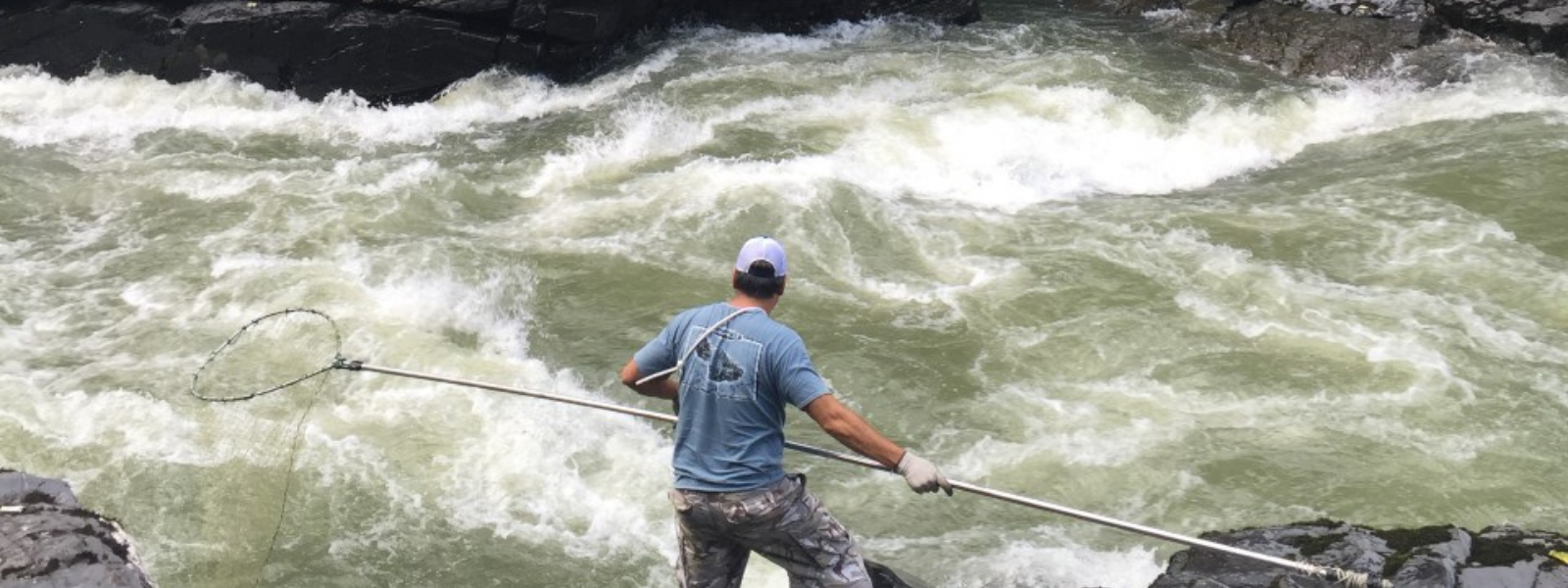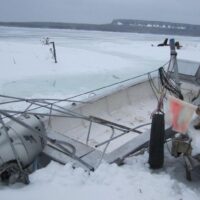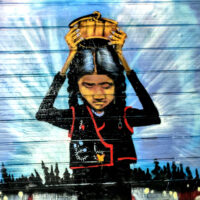Published as part of our Indigenous Perspectives series of Indigenous-led climate research, produced in co-operation with the Centre for Indigenous Environmental Resources.
This case study provides a foundation for a wider, more inclusive understanding of what it means to be resilient in an Indigenous context.
Many Indigenous Nations in British Columbia (B.C.) have maintained connection to their seasonal round of activities—the annual cycle of land-based practices that have sustained these Nations since time immemorial—despite the recent shifts that we are collectively experiencing as the climate changes. By using the seasonal round as a touchstone for adapting and continuing land-based activities, the application of each community’s values and protocols to the perception of resilience in their context can lead to a holistic and grounded demonstration of rez-ilience: our own understanding of how to be resilient.
The integration of both social and ecological aspects of resilience will reinforce the deep knowledge held by Indigenous Peoples of how to live sustainably, as well as how to successfully adapt to change. These inclusive and grounded understandings of rez-ilience can lead to more progressive, relevant, and effective climate policy and decision making. Indigenous Peoples have shown the efficacy of ecologically rooted resilience through our long histories of living in balance, in connection, and in harmony with the environment.
This case study is a continuation of the work I have been doing on my Master’s thesis, which looks at climate resilience in Indigenous communities. This case study is informed by my own living understandings of what Indigenous climate resilience is as a Gitxsan woman, and through interviews and surveys completed by Gitxsan community members. This study is supported by the work done by Gitxsan scholars before me.
Lip Seksinhl Jebin (Clean up the mess that you made)
Climate change—the warming of the atmosphere as a result of the burning of fossil fuels—is responsible for the worldwide increase in extreme weather, forest fires, disease transmission, pests, and species loss. Although the majority of the emissions responsible for climate change were released by colonial powers, the adverse impacts disproportionally affect Indigenous people (Abate and Kronk 2013; Donatuto et al. 2014; Green and Minchin 2014; Vinyeta et al. 2015; Chisholm Hatfield et al. 2018). The intense warming over the last fifty years can be linked to human-caused global greenhouse gas emissions from the extraction and burning of fossil fuels (United Nations 2020; IPCC 2020). This warming has caused significant changes in Gitxsan territory, and is beginning to shift the Gitxsan seasonal cycle of use. These changes to annual cycles and patterns, the seasonal round, are one more example among many of the consequences of the lack of balance and harmony in our relations with the Earth.
Because of this failure to connect the social and the ecological, the Eurocentric understandings of resilience that are dominant today are at odds with the kincentric and relational nature of Indigenous worldviews. In other words, within Indigenous worldviews, humans and nature share ancestry and origins. In other words, kin or relatives include all natural elements of life (Salmon 2000). Eurocentric understandings of resilience, on the other hand, speak of adapting and changing while remaining within a critical threshold (Berkes and Ross 2012). They leave no space for the deep relationships Indigenous people hold with their territories, nor for the sense of stewardship and responsibility that accompany these relationships. Lastly, these understandings do not account for the strength and resilience already demonstrated by Indigenous Peoples, who have survived colonization and past climatic changes and have continued to thrive.
Restoring balance is a difficult task. It involves viewing the Land as a relationship, and as a sacred responsibility between ancestors and kin (Turner and Clifton 2009; Whyte 2013; Whyte 2014; Snively and Williams 2016; Wilson et al. 2019). Defining and understanding rez-ilience in a way that reflects the strength, responsibility, and relationships to Land is a foundational step to building holistic and effective practices that reflect relationality, responsibility, and stewardship.
Living on the frontlines of this environmental crisis, Indigenous communities are adapting to climate change by using the same spirit of resilience they have demonstrated time and time again throughout history.
Daxgigethhl get elhl la’oo’m (The people were healthy long ago)
The Gitxsan (also spelled Gitksan) People are from the northwest coastal region, and live at the unceded confluence of the Skeena, Nass, and Bulkley Rivers in British Columbia. Gitxsan territory is mountainous and heavily forested, falling within the Interior Cedar Hemlock Biogeoclimatic Zone (Figure 1). Gitxsan territory occupies 33,000 square kilometres in the northwestern portion of the province and is slightly larger than the land area of Belgium (Main-Johnson 1997). The Gitxsan have occupied this area since glaciers retreated around 15,000 years ago or shortly thereafter, and have demonstrated their resilience since time immemorial. Today, there are six Gitxsan communities: Gitanmaax, Gitwangak, Gitsegukla, Gitanyow, Anspay’axw, and Sik-e-dahk.
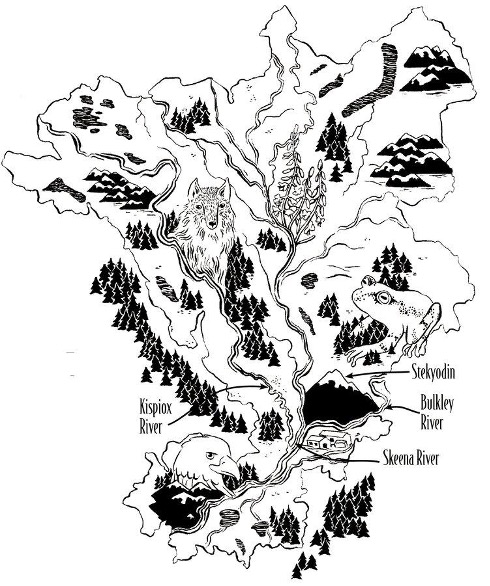
Culturally, the Gitxsan share similarities with the coastal Nations of the Pacific Northwest. Gitsenimx, the language of the Gitxsan people, is rooted in Tsimshianic, a language family spoken in the unceded territories of northwestern British Columbia and southeastern Alaska. Like other coastal people, the Gitxsan uphold the feast system. Within the feast system, there are four pdeeks (clans), which are passed down through the mother: Giskgaast (Fireweed), Lax Gibuu (Wolf), Lax Skiik (Eagle), and Lax Seel (Frog). Positionality within the huwilp (house) system governs many aspects of daily life, including resource and territory access and responsibility. The Gitxsan calendar recognizes 13 moons (months). Moons are descriptively named and those names give insight into phenomena occurring in the natural world during that month, as well as how the Gitxsan responded to those changes and events on the land (Table 1). The 13 moons in the Gitxsan seasonal round are divided up into four seasons: Gwooyim (spring—March, April, May); Sint (summer—June, July, August); Xwsit (fall—September, October); and Maadim (winter—November, December, January, and February).
| Gitxsan Moon (Month Approximate) | English translation |
|---|---|
| K’ uholxs (January) | Stories & feasting Moon |
| Lasa Hu’ mal (February) | Cracking Cottonwood & Opening Trails Moon |
| Wihlaxs (March) | Black Bear’s Walking Moon |
| Lasa Ya’a (April) | Spring Salmon’s Returning Home Moon |
| Lasa ‘Yanja (May) | Budding Trees & Blooming Flowers Moon |
| Lasa Maa’y (June) | Gathering & Preparing Berries Moon |
| Lasa ‘Wiihun (July) | Fisherman’s Moon |
| Lasa Lik’i’nxsw (August) | Grizzly Bear’s Moon |
| Lasa Gangwiikw (September) | Groundhog Hunting Moon |
| Lasa Xsin Laaxw (October) | Catching-Lots-Of-Trout Moon |
| Lasa Gwineekxw (November) | Getting-Used-to-Cold Moon |
| Lasa ‘Wiigwineekxw (December) | Severe Snowstorms & Sharp Cold Moon |
Gitxsan understandings of resilience are infused with a holistic understanding of ecosystem management. Gitxsan people know their place as a part of the Land and have a sense of responsibility to the Land. The Gitxsan community members I spoke with reinforced concepts of connection, respect, holism, balance, and ceremony, which contribute to good stewardship of territories. When asked, many of the words Gitxsan people use to describe resilience are reflected within the Gitxsan wheel of philosophy (Figure 2). The wheel of philosophy guides Gitxsan values, and therefore guides the interactions with the seasonal round on the Land. These values are upheld within the seasonal cycle and are a reflection of the respect the Gitxsan have for the Land and for each other, which uphold the sense of caretakership and responsibility that allowed the Gitxsan people to live sustainability for thousands of years.
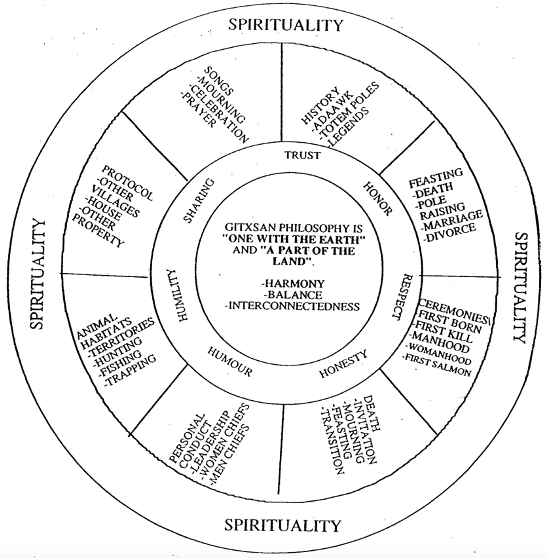
As Gitxsan scholar MJ Smith says, “Gitxsan spirituality was [holistic]: it is intimately connected with all things in nature. Animals, water, rocks, trees, and earth all have spirits and are all gifts from the creator…. Everything growing from the Land was a part of the Gitxsan. That was why the Gitxsan respected the Land and felt that it was sacred” (2004). The teachings, protocols, and ceremonies within the wheel of philosophy reinforce what it means to be Gitxsan, but also teach how to have good relations with the Land. In other words, the wheel summarizes the sustainable ways in which Gitxsan people lived for millennia, honoring harmony, balance, and interconnectedness in their relationship with the Land. These teachings inform Gitxsan rez-ilience, which I now understand to mean, Observing the changes occurring on the land, and working to uphold the teachings that have been passed down since time immemorial.
Aa’t’ikshl ‘wii t’ism wis (A storm is coming)
The Indian Act and Residential Schools restricted, as they did with many Nations, the authority of the Gitxsan people over their community, their governance, and their system of land and resource management. Despite this, the feast systems have persisted, and hereditary governance remains largely intact. Both colonial and traditional forms of governance operate within Gitxsan territory. Like many Indigenous Nations in B.C., the Gitxsan are in tune with the annual cycles of changing seasons. Gitxsan life and culture are founded on the seasonal cycles (Figure 3). The cycles influence the areas in which we as Gitxsan people live, hunt, harvest, and perform aspects of culture.
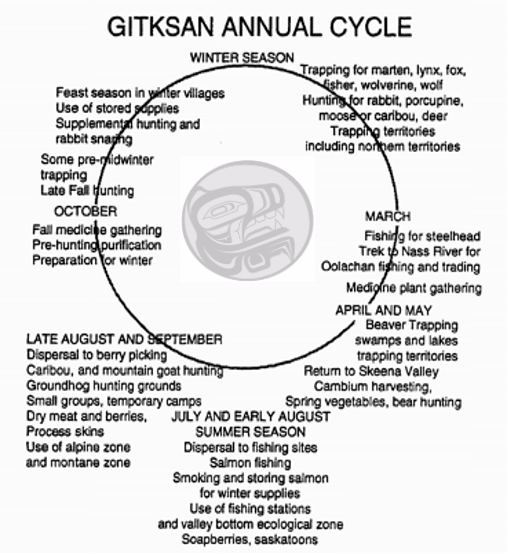
In the past, the turning of the seasons and the activities within each season were predictable. However, like many other places in B.C. and around the world, Gitxsan territory is experiencing variable temperatures, which impact the plants and animals. Climate change is altering the predictability of seasons, which changes the Gitxsan seasonal round. The descriptions of activities associated with each month in the Gitxsan lunar cycle no longer fit with the observed events on the landscape, and no longer reflect how the Gitxsan ancestors lived on the land. In an effort to better understand these changes in seasonality, I interviewed four Gitxsan community members, and collected 17 written surveys.
All of the participants spoke of the changes taking place throughout the Gitxsan territory, which influence how we, as Gitxsan people, are able to practice seasonal activities.
The timing and abundance of berries and medicines are different, for example. They are blooming at different times, which forces harvesters to choose between harvesting one species or another. During the heatwave of 2021, many of the plants showed visible signs of heat stress, which meant fewer berries to harvest. These destructive events are happening more and more, and are also beginning to impact other species that rely on these resources. The inconsistency in harvestable plants and forage affects the moose, who are not found as consistently throughout the territory.
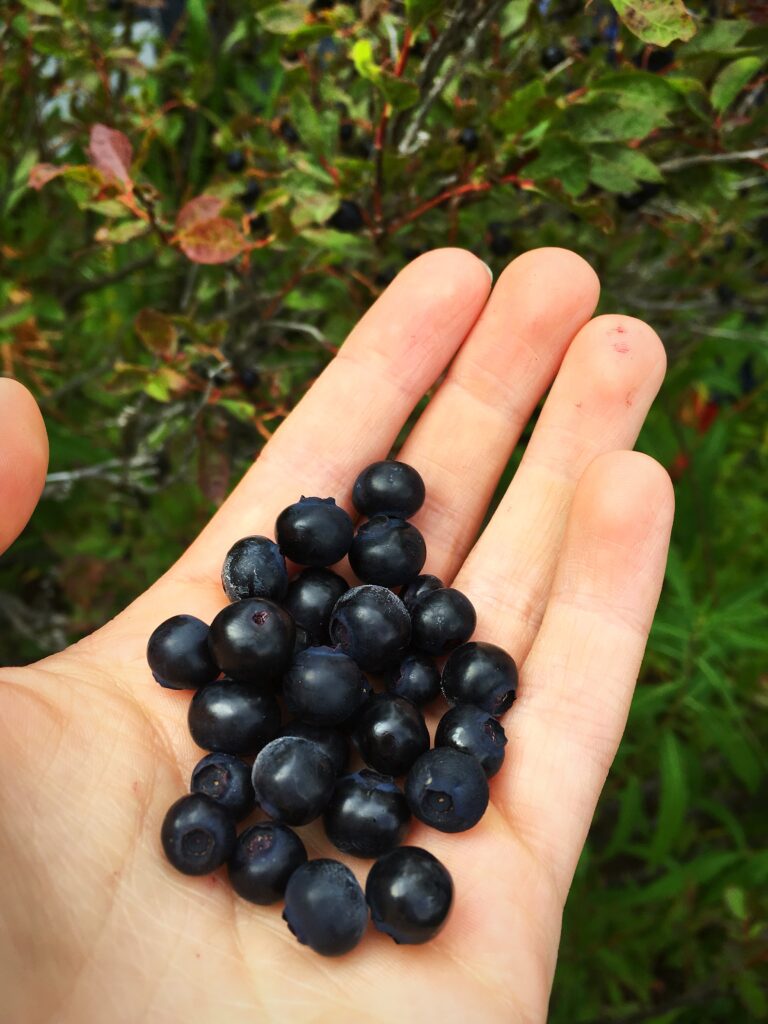
This is what we call a cascading effect: a shift that creates a series of other shifts. Xadaa (Moose) are an important species in Gitxsan territory; they often forage for vegetation during the same times as the Gitxsan. Moose are now seen less frequently and are not in the same areas they used to be. Having reduced access to moose not only destabilizes the ecosystem; it is also beginning to impact Gitxsan food security. Every year, there are fewer and fewer salmon, and they are often in worse condition. To the Gitxsan, the salmon are a culturally significant species. They are an important source of protein, are in a lot of Gitxsan stories, and hold a special place within the feast hall. Fewer salmon jeopardizes food security and the crucial link to culture and identity.

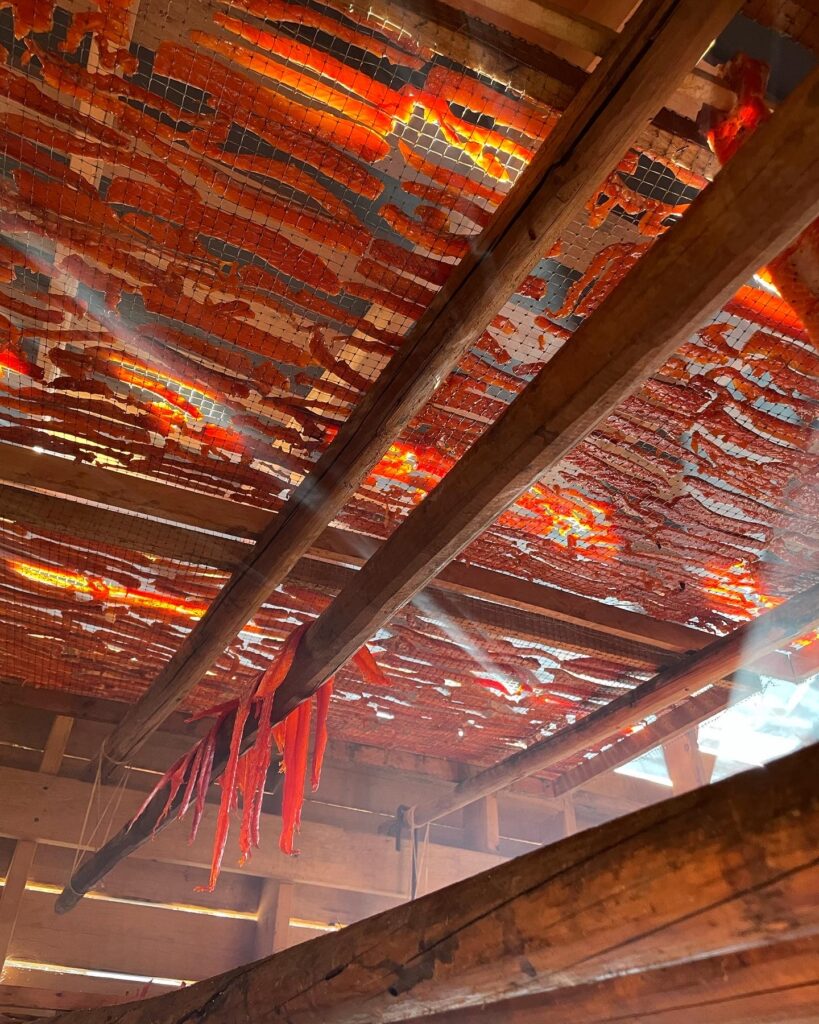
These changes are shifting the Gitxsan seasonal round of activities—the very ways in which we as Gitxsan people exist on the Land (Figure 4). In the Gitxsan worldview, resources are valued as intrinsic, as a food source, as a source of economy and trade, and as a connection to culture and identity. A changing climate “challenges the fundamental belief about how elements of the natural world are connected, as well as the timing of when traditional patterns occur and behaviors are formed” (Chisholm Hatfield et al. 2018). The Gitxsan view of seasons ties together timing and connections: it describes a whole-systems change, and how “interactions among things are moving in relationship to one another.”
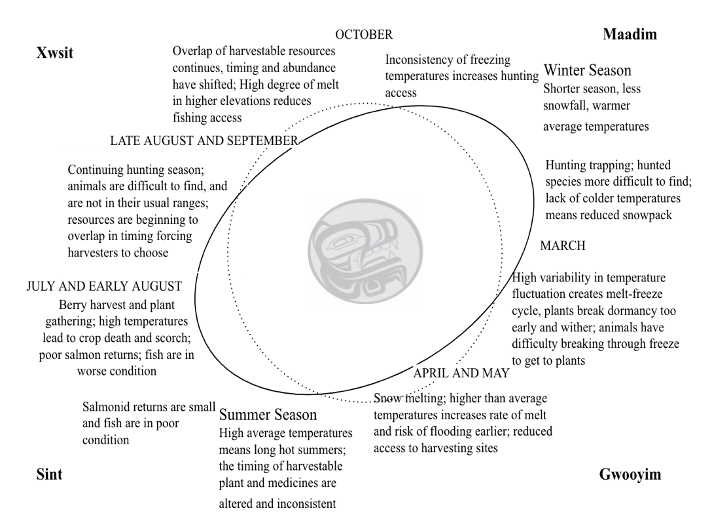
As the seasonal round shifts, culture, language, and the Gitxsan identity also shift. Culture and identity are founded on the Land and its cycles. As we are confronted with changes on the Land, we will be forced to try to adapt pieces of language, our culture, and our ways of knowing and being on the Land. However, it is important to understand that a change in relationship does not equate to a loss in relationship. Redefining our relationships with the Land to include contemporary uses and ongoing adaptation to a changing climate is at the very centre of rez-ilience.
Indigenous values, concepts, and ways of being are not reflected in the way government thinks about resilience. The lack of a definition inclusive of community-land relationships, stewardship, responsibility, and kincentric bonds has contributed to climate policies and management strategies that are inequitable and cede far too much power to the settler state. Policies devoid of relationship, responsibility, and accountability to the Land and our relations work to further capitalism, economy, and extraction at the expense of community, ecology, relationship, and reciprocity.
Yukw na Hagwil yin (Learning to walk softly)
Common understandings of resilience assume it refers simply to the ability to recover from shocks and stress (Summers et al. 2016). A lack of a compatible understanding of resilience, rooted in relationship, undermines the ability of Indigenous and non-Indigenous people alike to practice resilience. Too often, imposed understandings of resilience exclude Gitxsan practices, values, and philosophies upheld in feast halls, in ceremony, and in ways of knowing and being. Imposed approaches to resilience also inhibit our ability to implement creative, applicable, and encompassing management solutions and adaptation strategies that incorporate Gitxsan expressions and worldview. In essence, they do not make space for the kincentric relationships and responsibilities that inform the Gitxsan culture and worldview.
A key part of understanding Gitxsan rez-ilience is acknowledging the resilience that has always been demonstrated and then applying that same spirit of strength to facing climate change. Based on what I have learned and what I have been taught, to me, Gitxsan rez-ilience is the ability to weave together all that we have learned from the past into rising to the challenges of the present and the future. In other words, Gitxsan rez-ilience is strength-based and holistic. It is founded on a sense of responsibility to maintain the Land and exists in relationship to the Land, much as Gitxsan people do. Further, Gitxsan rez-ilience is the ability to persist and survive. It is the ability to uphold traditional laws, ceremony, and protocols of management that were successful in the past, and to adapt them for current needs, goals, and dreams. It is balanced, interconnected, and harmonious. It is rooted in relationships and is founded on the responsibility that Gitxsan people have to steward and take care of the Land for future generations. It should be understood that as with the Gitxsan themselves, this definition and understanding of rez-ilience will adapt, grow, and change.[1]
By combining the teachings of the Gitxsan wheel of Philosophy with the shifting timing of the seasonal round, we arrive at what it means to be resilient within a Gitxsan context.
The seasonal round teaches how and when to be on the land, and the wheel of philosophy teaches how to carry oneself with respect to relationships and responsibilities as a kincentric people.
Understanding this, effective climate policy needs to be approached holistically: it needs to make space for responsibility, accountability, and relationship. It must incorporate place-based values that take into account the intensity of the changes we are seeing within the seasonal cycle across “Canada.” Only then will resilience be inclusive of harmony, balance, and interconnectedness, and only then will it reflect Gitxsan understandings of their place within human-ecosystem relationship
Emerging from this research, and rooted in this understanding of resilience, I would offer the following recommendations for policy makers at all orders of government:
- Incorporate a place-based lens to climate adaptation, emergency management, and resilience policy. Having policy that is aligned with each Nation’s values, understandings, and philosophies would increase effectiveness and lead to better outcomes. Further, it would start to undo some of the colonial assumptions about human-Land relationships that are entrenched in federal, provincial, and territorial policies.
- Include seasonal considerations in decision making. Considering seasonality when looking to increase resilience would strengthen ecological resilience while reinforcing social resilience (upholding the ayookxw of the Gitxsan and other Nations, who are in tune with the seasonal changes). Climate policy needs to be designed to consider the changes and needs of each Nation in each season, rather than as year-round blanket statements.
- Manage for Naadahahlhakwhlinhl (interconnections with all living things). The mismanagement of our resources can largely be traced to fracturing of the Land and our relationship to it. These fractures are reflected in colonial government structures, and therefore are embedded in policy. Effective climate policy needs to be holistic in nature: appreciating the responsibility we have to the big picture, while considering the smaller working pieces.
In my understanding, Yukw na Hagwil yin translates roughly to “learning to walk softly.” In Gitxsan culture, Walk Softly is a reminder to take care in carrying yourself and in how you act. It teaches you to think of those around you, including your non-human relations, and to think of how your actions and words affect them. Learning to walk softly when thinking about resilience to climate change is important. It is a reminder of responsibility to generations coming after us, who will be left to deal with the decisions we make and the world we create. It is understanding how our actions as humans, as Gitxsan, affect the state of our environment, and how the decisions made today will impact the generations coming after us, for seven generations.
The key, moving forward, is to approach resilience to climate change with the same strength of spirit that the ancestors embodied. Look to the teachings in the seasonal round and know that there is a time for everything. Look to the teachings of values and culture and know that resilience is built into Indigenous identities. Look at all we have been through as Indigenous people—and we are still here.
Each Nation will have to determine what values, strengths, and protocols define their expressions of rez-ilience. Since colonialism has impacted every Nation across “Canada” differently, we have many expressions of Indigenous rez-ilience to draw on. We are revitalizing our practices, our languages, and our ways of being on the Land.
Building resilience is a journey. I firmly believe that we as Indigenous Peoples are meant to be leading this work. Our responsibility is to take this work as far as we can, so the next generation can pick it up and continue the journey. This case study and my own understandings of resilience that I share here are a part of my contribution to the larger journey that we are all on together.
[1] These are my own understandings based on my research and what I have been taught—I cannot speak on behalf of my community or my Nation
Appendix A – Glossary of Gitxsan Terms
Adawaak: The oral history of each Wilp.
Ayookxw: Gitxsan laws that ensure peace and order for the Huwilp.
Daax litxwit: Still standing—aassociated with Gitxsan resilience[DM1]
Deex Goot: Steady, unwavering heart—associated with Gitxsan resilience
Giskgaast: Fireweed/Killer whale Clan
Huwilp: The collective of eight Wilp that collectively constitute the Gitxsan People
Lax Gibuu: Wolf Clan
Lax Skiik: Eagle Clan
Lax Seel: Frog Clan
Lax’yip: The ancestral territories of the Gitxsan
Luis yaltxw: Restored from hard times—associated with Gitxsan resilience
Otsin: Spirit of our People—associated with Gitxsan resilience
Pdeek: Clan—there are four Gitxsan clans (Wolf, Frog, Eagle, Fireweed/ Killer whale)
Wilp: House group—the primary political, social, and decision-making unit of the Gitxsan, each with its own well-defined territories managed according to a strong and enduring system of land management.Xadaa: Moose—a cultural and dietary staple of the Gitxsan People
Appendix B – Voices of the Gitxsan
In completing this case study and as a part of my Master’s thesis research, I had the chance to speak to and learn from many Gitxsan people. It is important that their voices be recognized in this work, and that their understandings and observations be honoured in sharing what I think and have learned of Gitxsan resilience. It should be noted that this is only a piece of Gitxsan resilience, and that I am still learning. My voice is not reflective of the Gitxsan Nation as a whole.
Here are some of the insights that were shared with me in my interviews with Gitxsan people:
“Preventative measures are being taken to ensure resilience at a local level. Observation of forests, water, and numerous species of flora and fauna is underway. Limiting use of resources, only hunting and harvesting as necessary. Exploring renewable energies and alternatives to exploitative industry. Upholding the wilp governance system and Gitxsan legal order to ensure the future of the territory.”
“Salmon are very important to Gitxsan people. We are probably made of salmon—a major part of our diet for thousands of years and a major part of our culture.”
“Everything is connected and all things are affected by man. Take too many trees and it causes flooding. The balance with nature depends on loggers and fisherman. Take too much and the supply is diminished.”
“The laws are still in place—people are pretty strong. Talking to elders, these values don’t go away.”
“It is just so unpredictable now—we used to know when the water would rise and fall and when the rain would come, but it is so different now.”
“Moose are harder to hunt in the fall, which it never was before. The resources are scarce, they have moved everywhere and are in different places. It seems like when we do find them there are less, and in different spots than we have found them in the past.”
“Yes, the feast system is still in place for it will always be our ayookxw (laws), our laws that will keep carrying on for generations.”
“Our territorial management plan is in effect based on the wilp membership, not Indian status membership. This doesn’t mean that we have respect from the province or Canada as it pertains to our territorial management plan.”
“If there’s too much rain, there’s no harvesting berries. This year we don’t have enough rain. The soap berries are turning red already; it usually extends until huckleberries are ready.”
“It is called our lax yip (territory). This is where we got all our stories, which are so important. The elders looked after it for us, and now we have to look after it for future generations that are coming.”
References
Berkes, Fikret, and Helen Ross. “Community Resilience: Toward an Integrated Approach.” Society & Natural Resources 26, no. 1 (2013): 5–20. https://doi.org/10.1080/08941920.2012.736605
Cajete, Gregory A. “Indigenous Science, Climate Change, and Indigenous Community Building: A Framework of Foundational Perspectives for Indigenous Community Resilience and Revitalization.” Sustainability 12, no. 22 (2020): 9569. https://doi.org/10.3390/su12229569
Ford, James D., Nia King, Eranga K. Galappaththi, Tristan Pearce, Graham McDowell, and Sherilee L. Harper. “The Resilience of Indigenous Peoples to Environmental Change.” One Earth 2, no. 6 (2020): 532–43. https://doi.org/10.1016/j.oneear.2020.05.014
Galappaththi, Eranga K., James D. Ford, Elena M. Bennett, and Fikret Berkes. “Climate Change and Community Fisheries in the Arctic: A Case Study from Pangnirtung, Canada.” Journal of Environmental Management 250 (2019): 109534. https://doi.org/10.1016/j.jenvman.2019.109534
Main-Johnson, Leslie. “Health, Wholeness, and the Land: Gitksan Traditional Plant Use and Healing.” UBC Circle, 1997.
Salmon, Enrique. “Kincentric Ecology: Indigenous Perceptions of the Human-Nature Relationship.” Ecological Applications 10, no. 5 (2000): 1327. https://doi.org/10.2307/2641288
Smith, Jane. “Placing Gitxsan Stories in Text: Returning the Feathers. Guuxs Mak’Am Mik’Aax.” UBC Circle, 2004. https://doi.org/10.24124/2000/bpgub137
Snively, Gloria, and Lorna Williams. “Knowing Home: Braiding Indigenous Knowledge with Western Science.” University of Victoria, 2016.
Summers, J. Kevin, Lisa M. Smith, Linda C. Harwell, and Kyle D. Buck. “Conceptualizing Holistic Community Resilience to Climate Events: Foundation for a Climate Resilience Screening Index.” GeoHealth 1, no. 4 (2017): 151–64. https://doi.org/10.1002/2016gh000047
Turner, Nancy J., and Helen Clifton. “‘It’s so Different Today’: Climate Change and Indigenous Lifeways in British Columbia, Canada.” Global Environmental Change 19, no. 2 (2009): 180–90. https://doi.org/10.1016/j.gloenvcha.2009.01.005
Whyte, Kyle Powys. “Indigenous Women, Climate Change Impacts, and Collective Action.” Hypatia 29, no. 3 (2014): 599–616. https://doi.org/10.1111/hypa.12089
Whyte, Kyle Powys. “Justice Forward: Tribes, Climate Adaptation and Responsibility.” Climate Change and Indigenous Peoples in the United States, 2013, 9–22. https://doi.org/10.1007/978-3-319-05266-3_2 Wilson, Nicole, Leila Harris, Angie Joseph-Rear, Jody Beaumont, and Terre Satterfield. “Water Is Medicine: Reimagining Water Security through Tr’Ondëk Hwëch’in Relationships to Treated and Traditional Water Sources in Yukon, Canada.” Water 11, no. 3 (2019): 624. https://doi.org/10.3390/w11030624
